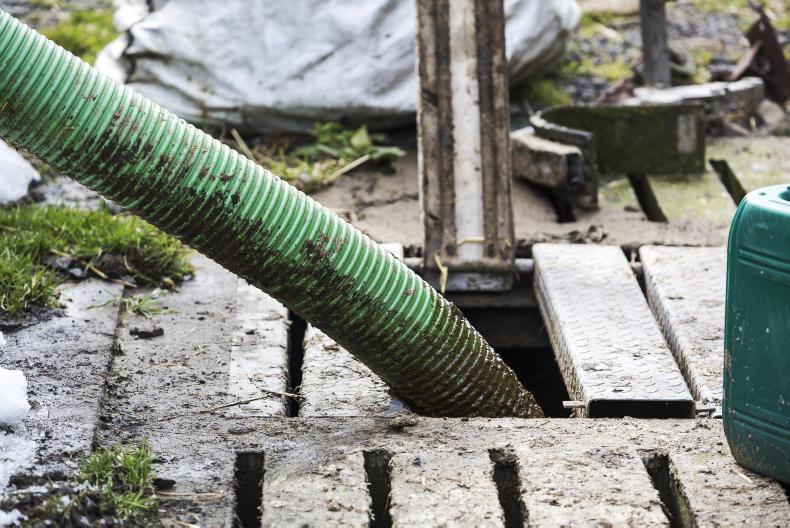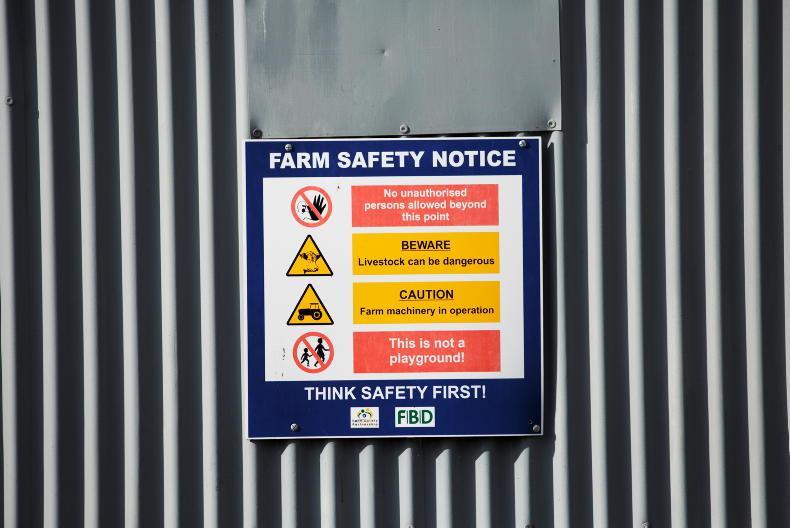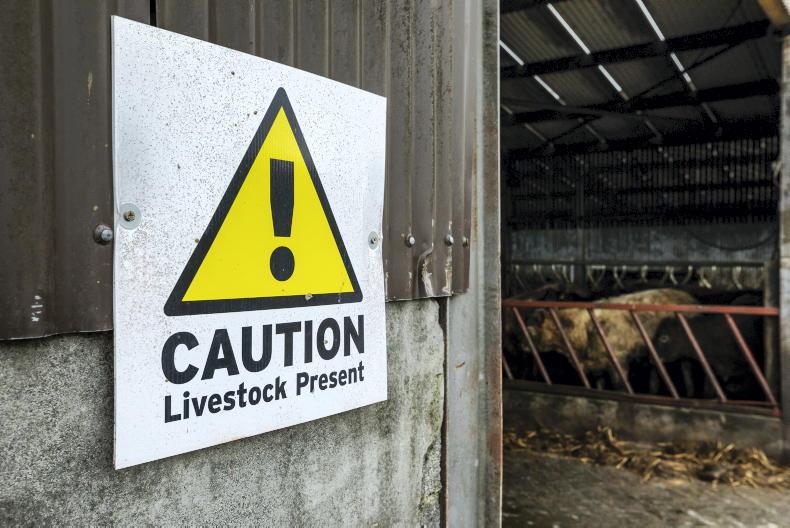Slurry is one of the main causes of death and serious injury on Irish farms. The fumes released as slurry is agitated can be lethal, especially when a crust has formed on the top of the slurry. Remember, there is no safe slurry tank.
When that crust of slurry is broken, hydrogen sulphide (H2S), ammonia and methane are released. Hydrogen sulphide is the biggest danger because it is a colourless gas. If the concentration of H2S is strong enough, between 700 and 2,000 parts per million, it can kill almost immediately.
One sniff of the fumes at even at 40ppm can disable the ability to smell anything and the second and third sniffs of a higher concentration can kill somebody within 10 seconds. Fresh air in the shed is the key thing in prevention. It is important to aerate the shed by opening all the doors to allow entry of a moderate breeze within the shed as you are agitating.
Working safely with slurry
Some farmers are inclined take chances during slurry agitation because the slurry gas risk can be variable and difficult to predict. Slurry gas is always present during agitation, even if you do not notice it.
A combination of conditions can easily result in you and your animals suddenly being in serious danger. Slurry from animals fed high-concentrate diets, such as bulls, can have a higher concentration of the lethal slurry gas present. Agitation of these cattle sheds requires great care and a longer time to allow the gas to be fully cleared from the shed.

The lethal slurry is released within the first 30 minutes of agitation, so stay out of all sheds and keep all doors and vent areas open to allow the gases to escape.
Mixing slurry
At high concentrations, it is not possible to smell hydrogen sulphide. The gas is generally given off in large volumes very soon after mixing starts. The first 30 minutes are the most dangerous. After this time, the quantity of slurry gas released falls off.
However, each time the agitator/pump is repositioned to mix another part of the shed/tank, the gas concentration rises again. You need to stay out of the building for at least another 30 minutes or longer depending on the size of the tank after the agitation begins.
Before you start slurry agitation
The advice from the Health and Safety Authority is to stop and think before working with or near slurry.
Think about the job you are going to do and make preparations to do the entire task safely.Think about vital preparations – check that the tractor and tanker are in good repair, brakes and tyres in good condition and if they have to be positioned above the tank, make sure the slats can take the weight, particularly if using new, heavier machinery.Think about ensuring all openings are covered to prevent a fall into the slurry tank.Think about keeping animals and children well away when working with slurry.The gas is lethal because it is heavier than air. During slurry agitation the gas will settle in a cloud over the top of the slurry. Bending down into the gas cloud for even a few moments can cause unconsciousness.
Slurry pump
Tractor-mounted slurry pumps are designed to allow the PTO shaft to remain attached to the tractor when the pump is being transported. It is essential that the two lower lift arms on the tractor are properly latched and locked into the two brackets on the slurry pump linkage frame before the top link or PTO shaft are attached. When not in use, it is very important that the pump is parked using the support legs on a hard and level surface.
Gas concentration meters
Handheld monitors are available and can, if properly maintained and calibrated, provide a warning of high gas levels. They should always be regarded only as a backup to a safe system of work, never a substitute.
They can be a useful guide before entering a building after mixing is complete to check the gas has had time to disperse. Never rely on a meter at the start of mixing – gas concentration rises so quickly it is dangerous to remain in the building. A meter will not give adequate warning or time to escape.
Helping someone overcome by gas
If possible, stop the pump and get the person to fresh air, but do not put yourself at risk in the process. If breathing is weak or stopped, artificial respiration may be effective. Get emergency medical attention immediately.
Slurry agitation checklist
Always
Assume hazardous gas is present during mixing.Keep all unnecessary openings to slurry tanks covered.Follow the safe system of work outlined below to stay out of trouble.If possible, mix on a windy day.Keep children away from the area at all times when working with slurry.Take all animals out of the building before starting to mix slurry.Open all doors and windows.Use outside mixing points first.If slats are removed, cover exposed areas of the tank beside the pump/mixer to stop anything falling in.Start the pump/mixer and then stay out of the building for as long as possible – at least 30 minutes or longer depending on the size of the tank.If you have to go into the building, make sure that another adult who knows what you are doing stays outside and can get help if needed.If you have to re-enter to move the pump, or change the direction of the pump, leave the building as soon as this is done. Do not go back in for as long as possible – at least another 30 minutes or longer depending on the size of the tank.Never
Rely on filter-type face masks.Use gas monitors/meters as a substitute for a safe method of working.Rely on meters at the start of mixing.Have naked flames near slurry, as slurry gas mixture is flammable.Stand close to the pump/exhaust of a vacuum tanker when it is being filled.There is no safe slurry tank. The gases can kill people and animals almost instantly. Prevent accidents and save lives by always following the safe system of work.
In an emergency
Call 999 and tell them slurry gas may be present.
If possible, stop the pump and get the person to fresh air.Don’t put yourself at risk – people have died trying to save others.
Slurry is one of the main causes of death and serious injury on Irish farms. The fumes released as slurry is agitated can be lethal, especially when a crust has formed on the top of the slurry. Remember, there is no safe slurry tank.
When that crust of slurry is broken, hydrogen sulphide (H2S), ammonia and methane are released. Hydrogen sulphide is the biggest danger because it is a colourless gas. If the concentration of H2S is strong enough, between 700 and 2,000 parts per million, it can kill almost immediately.
One sniff of the fumes at even at 40ppm can disable the ability to smell anything and the second and third sniffs of a higher concentration can kill somebody within 10 seconds. Fresh air in the shed is the key thing in prevention. It is important to aerate the shed by opening all the doors to allow entry of a moderate breeze within the shed as you are agitating.
Working safely with slurry
Some farmers are inclined take chances during slurry agitation because the slurry gas risk can be variable and difficult to predict. Slurry gas is always present during agitation, even if you do not notice it.
A combination of conditions can easily result in you and your animals suddenly being in serious danger. Slurry from animals fed high-concentrate diets, such as bulls, can have a higher concentration of the lethal slurry gas present. Agitation of these cattle sheds requires great care and a longer time to allow the gas to be fully cleared from the shed.

The lethal slurry is released within the first 30 minutes of agitation, so stay out of all sheds and keep all doors and vent areas open to allow the gases to escape.
Mixing slurry
At high concentrations, it is not possible to smell hydrogen sulphide. The gas is generally given off in large volumes very soon after mixing starts. The first 30 minutes are the most dangerous. After this time, the quantity of slurry gas released falls off.
However, each time the agitator/pump is repositioned to mix another part of the shed/tank, the gas concentration rises again. You need to stay out of the building for at least another 30 minutes or longer depending on the size of the tank after the agitation begins.
Before you start slurry agitation
The advice from the Health and Safety Authority is to stop and think before working with or near slurry.
Think about the job you are going to do and make preparations to do the entire task safely.Think about vital preparations – check that the tractor and tanker are in good repair, brakes and tyres in good condition and if they have to be positioned above the tank, make sure the slats can take the weight, particularly if using new, heavier machinery.Think about ensuring all openings are covered to prevent a fall into the slurry tank.Think about keeping animals and children well away when working with slurry.The gas is lethal because it is heavier than air. During slurry agitation the gas will settle in a cloud over the top of the slurry. Bending down into the gas cloud for even a few moments can cause unconsciousness.
Slurry pump
Tractor-mounted slurry pumps are designed to allow the PTO shaft to remain attached to the tractor when the pump is being transported. It is essential that the two lower lift arms on the tractor are properly latched and locked into the two brackets on the slurry pump linkage frame before the top link or PTO shaft are attached. When not in use, it is very important that the pump is parked using the support legs on a hard and level surface.
Gas concentration meters
Handheld monitors are available and can, if properly maintained and calibrated, provide a warning of high gas levels. They should always be regarded only as a backup to a safe system of work, never a substitute.
They can be a useful guide before entering a building after mixing is complete to check the gas has had time to disperse. Never rely on a meter at the start of mixing – gas concentration rises so quickly it is dangerous to remain in the building. A meter will not give adequate warning or time to escape.
Helping someone overcome by gas
If possible, stop the pump and get the person to fresh air, but do not put yourself at risk in the process. If breathing is weak or stopped, artificial respiration may be effective. Get emergency medical attention immediately.
Slurry agitation checklist
Always
Assume hazardous gas is present during mixing.Keep all unnecessary openings to slurry tanks covered.Follow the safe system of work outlined below to stay out of trouble.If possible, mix on a windy day.Keep children away from the area at all times when working with slurry.Take all animals out of the building before starting to mix slurry.Open all doors and windows.Use outside mixing points first.If slats are removed, cover exposed areas of the tank beside the pump/mixer to stop anything falling in.Start the pump/mixer and then stay out of the building for as long as possible – at least 30 minutes or longer depending on the size of the tank.If you have to go into the building, make sure that another adult who knows what you are doing stays outside and can get help if needed.If you have to re-enter to move the pump, or change the direction of the pump, leave the building as soon as this is done. Do not go back in for as long as possible – at least another 30 minutes or longer depending on the size of the tank.Never
Rely on filter-type face masks.Use gas monitors/meters as a substitute for a safe method of working.Rely on meters at the start of mixing.Have naked flames near slurry, as slurry gas mixture is flammable.Stand close to the pump/exhaust of a vacuum tanker when it is being filled.There is no safe slurry tank. The gases can kill people and animals almost instantly. Prevent accidents and save lives by always following the safe system of work.
In an emergency
Call 999 and tell them slurry gas may be present.
If possible, stop the pump and get the person to fresh air.Don’t put yourself at risk – people have died trying to save others. 









SHARING OPTIONS